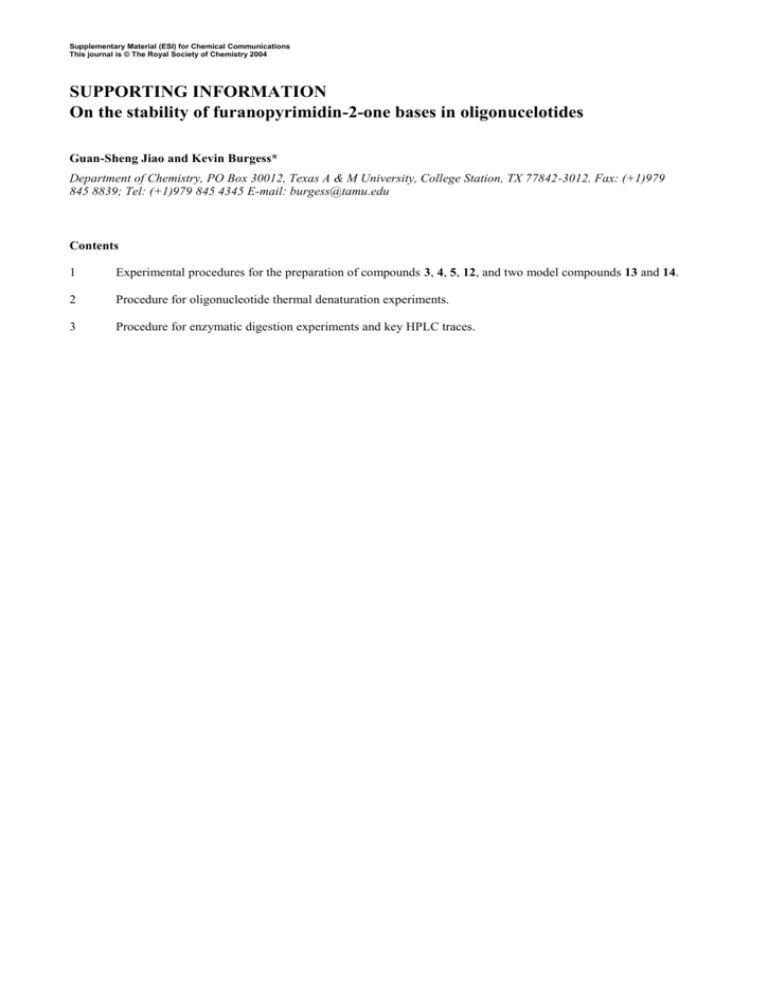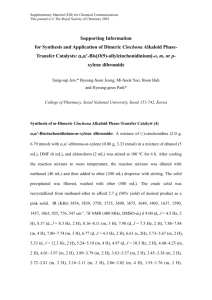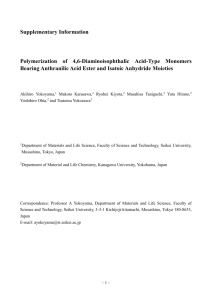RSC Communications Template (Mac)
advertisement

Supplementary Material (ESI) for Chemical Communications This journal is © The Royal Society of Chemistry 2004 SUPPORTING INFORMATION On the stability of furanopyrimidin-2-one bases in oligonucelotides Guan-Sheng Jiao and Kevin Burgess* Department of Chemistry, PO Box 30012, Texas A & M University, College Station, TX 77842-3012. Fax: (+1)979 845 8839; Tel: (+1)979 845 4345 E-mail: burgess@tamu.edu Contents 1 Experimental procedures for the preparation of compounds 3, 4, 5, 12, and two model compounds 13 and 14. 2 Procedure for oligonucleotide thermal denaturation experiments. 3 Procedure for enzymatic digestion experiments and key HPLC traces. Supplementary Material (ESI) for Chemical Communications This journal is © The Royal Society of Chemistry 2004 1 Experimental procedures for the preparation of compounds 3, 4, 5, 12, and two model compounds 13 and 14. OAc O O NH O O O AcO O O AcO OAc N + O (i) O DMTO N O I 1 N OH O DMTO O 2 O R 3R=H (ii) 4R= i Pr2N P O CN (iii) 5'-TCA ACG ZAG CTG A-3' 5 Scheme S1. Reagents and conditions: (i) cat. Pd(PPh3)4, CuI, NEt3, THF, 55 °C, 12h, 74 %; (ii) ClP(NiPr2)(OCH2CH2CN), EtNiPr2, CH2Cl2, 25 °C, 4h, 55 %; (iii) standard DNA solid phase synthesis procedure. Compound 3. 5-Iodofluorescein diacetate 11 (103 mg, 0.190 mmol) and 5-alkynyluracil derivative 22 (100 mg, 0.190 mmol) were placed in a Schlenk flask. Pd(PPh3)4 (11 mg, 0.010 mmol) and CuI (4 mg, 0.019 mmol) were then weighed in glove box. To this mixture were added 1.0 mL of THF and 0.3 mL of Et3N stepwise. The resulting solution was freeze/thaw degassed three times. The reaction mixture was then heated at 55 C under N2 for 12 h. After cooling, the reaction mixture was concentrated to give the brown crude residue, which was further purified by flash column chromatography (40 % EtOAc/CH2Cl2 to 1 % MeOH/40 % EtOAc/CH2Cl2) to give 3 as a pale yellow solid (135 mg, 74 % yield). 1H NMR (500 MHz, [d6]acetone): = 9.00 (s, 1H), 8.25 (d, J = 1.0 Hz, 1H), 8.07 (dd, J = 8.1, 1.7 Hz, 1H), 7.51 (dd, J = 8.55, 1.5 Hz, 2H), 7.47 (d, J = 8.1 Hz, 1H), 7.40 (dd, J = 9.0, 2.4 Hz, 4H), 7.34 (t, J = 7.3 Hz, 2H), 7.25 (t, J = 7.3 Hz, 1H), 7.20 (d, J = 2.2 Hz, 2H), 7.02 (dd, J = 8.8, 2.0 Hz, 2H), 6.94 (dd, J = 8.7, 2.2 Hz, 2H), 6.90 (t, J = 8.8 Hz, 4H), 6.43 (s, 1H), 6.23 (dd, J = 6.6, 4.4 Hz, 1H), 4.78 (t, J = 4.4 Hz, 1H), 4.75 (d, J = 4.4 Hz, 1H), 4.20 – 4.18 (m, 1H), 3.74 (s, 3H), 3.72 (s, 3H), 3.59 (dd, J = 10.7, 3.4 Hz, 1H), 3.50 (dd, J = 10.7, 2.9 Hz, 1H), 2.68 2.64 (m, 1H), 2.46 2.42 (m, 1H), 2.27 (s, 6H); 13C NMR (125.8 MHz, [d6]acetone): = 172.36, 169.28, 168.54, 159.70, 159.64, 154.88, 153.55, 153.50, 152.92, 152.22, 145.48, 139.64, 136.75, 136.33, 132.29, 131.97, 131.10, 130.91, 129.94, 129.14, 128.85, 128.08, 127.77, 125.78, 121.21, 119.20, 117.07, 117.06, 114.11, 114.09, 111.28, 107.31, 102.10, 89.03, 87.67, 87.49, 82.21, 70.21, 63.19, 55.51, 42.59, 20.93; ESI-MS calcd for C56H44N2O14: 968.3, found: 969.2 [(M+H)+]. Compound 4. Furanopyrimidin-2-one nucleoside 3 (100 mg, 0.104 mmol) was dissolved in 5 mL of CH2Cl2. To this solution were added EtNiPr2 (0.07 mL, 0.416 mmol) and 2-cyanoethyl di-isopropylchlorophosphoramidite (0.05 mL, 0.207 mmol) stepwise via a syringe. The reaction mixture was stirred at room temperature under N2 for 4 h. Removal of solvent under reduced pressure gave a brown residue, which was purified by flash column chromatography (10 – 20 % EtOAc/CH2Cl2) to provide 4 as a white solid (66 mg, 55 % yield). 1H NMR (500 MHz, [d6]acetone): = 9.05 (s, 1H), Supplementary Material (ESI) for Chemical Communications This journal is © The Royal Society of Chemistry 2004 8.26 (d, J = 1.7 Hz, 1H), 8.13 (dd, J = 8.3, 1.7 Hz, 1H), 7.57 – 7.54 (m, 3H), 7.44 (d, J = 8.6 Hz, 4H), 7.38 (t, J = 7.3 Hz, 2H), 7.30 (t, J = 7.3 Hz, 1H), 7.23 (d, J = 2.2 Hz, 2H), 7.05 (dd, J = 8.6, 2.0 Hz, 2H), 6.98 6.93 (m, 6H), 6.41 (s, 1H), 6.26 (dd, J = 6.6, 4.2 Hz, 1H), 4.97 4.92 (m, 1H), 4.35 (t, J = 5.6 Hz, 1H), 4.34 4.32 (m, 1H), 3.79 (s, 3H), 3.76 (s, 3H), 3.73 3.68 (m, 2H), 3.64 (dd, J = 11.0, 3.2 Hz, 1H), 3.58 (dd, J = 11.0, 2.9 Hz, 1H), 2.78 2.76 (m, 1H), 2.68 (t, J = 6.1 Hz, 2H), 2.64 2.61 (m, 1H), 2.62 (t, J = 6.1 Hz, 2H), 2.29 (s, 6H), 1.22 (t, J = 7.1 Hz, 12H); 31P NMR (121.4 MHz, [d6]acetone): = 150.09, 149.99 (diastereomers); ESI-MS calcd for C65H61N4O15P: 1168.4, found: 1169.3 [(M+H)+]. Oligonucleotide 5 and Non-modified Oligonucleotides. Oligodeoxynucleotide syntheses were performed on an ABI 394 RNA/DNA synthesizer from 3'-5' end using standard automated DNA synthesis protocol at 1.0 mol scale. A 0.1 M solution of 4 in dry acetonitrile was prepared and installed on the DNA synthesizer in a standard reagent bottle. Standard solid-phase DNA synthesis was automatically performed. During coupling of 4, the coupling time was extended to 5 min to ensure reaction completion. The resulting oligonucleotide was deprotected in 30 % NH4OH at 55 C overnight and purified by reverse-phase HPLC (solvents A = 70 % acetonitrile in 0.1 M Et3NHOAc aqueous buffer, B = 0.1 M Et3NHOAc aqueous buffer; 20 to 90 % A in 25 min; C18 column) to provide 5 and confirmed by MALDI-TOF or ESI-MS. 5. 5’-TCA ACG ZAG CTG A-3’, Calc'd: 4297, found 4296; 5’-TCA ACG CAG CTG A-3’, Calc'd: 3944, found 3945; 5’-TCA ACG TAG CTG A-3’, Calc'd: 3957, found 3957; 5’-TCA ACG AAG CTG A-3’, Calc'd: 3968, found 3968; 5’-TCA GCT GCG TTG A-3’, Calc'd: 3966, found 3968; 5’-TCA GCT ACG TTG A-3’, Calc'd: 3950, found 3949. Supplementary Material (ESI) for Chemical Communications This journal is © The Royal Society of Chemistry 2004 OAc O O O O O AcO HO CO2H (i) O O N N N O N DMTO O HO O O OH OH 3 15 O O CO2H (ii) O HO NH O N O HO O OH 12 Scheme S2. Reagents and conditions: (i) ZnBr2, CH2Cl2, iPrOH, 25 °C, 1 h, then NEt3, H2O, 5 min, 73 %; (ii) NaOH (2N), THF, 25 °C, 6 h, 10 %. Compound 15. A 1 M stock solution of ZnBr2 in CH2Cl2/iPrOH (85/15 v/v) was prepared. Compound 3 (30 mg, 0.031 mmol) was weighed into a round bottom flask. Then 2 mL of the ZnBr2 stock solution was added. The mixture was stirred at 25 °C for 1 h, then 2 mL of NEt3 and 0.2 mL of water were added. The reaction mixture was further stirred at 25 °C for 5 min. The residue after removal of solvents under reduced pressure was purified by flash column chromatography (10 – 30 % MeOH/CH2Cl2) to give pure 15 as an orange solid (15 mg, 73 % yield). 1H NMR (500 MHz, CD3OD): = 9.08 (s, 1H), 8.43 (d, J = 1.2 Hz, 1H), 8.12 (dd, J = 8.1, 1.7 Hz, 1H), 7.32 (s, 1H), 7.32 (d, J = 8.1 Hz, 1H), 6.83 (d, J = 8.8 Hz, 2H), 6.68 (d, J = 2.4 Hz, 2H), 6.58 (dd, J = 8.8, 2.4 Hz, 2H), 6.31 (t, J = 6.1 Hz, 1H), 4.42 – 4.40 (m, 1H), 4.09 (dd, J = 7.3, 3.7 Hz, 1H), 3.92 (dd, J = 12.2, 3.2 Hz, 1H), 3.81 (dd, J = 12.2, 3.6 Hz, 1H), 2.66 2.62 (m, 1H), 2.28 2.23 (m, 1H); 13C NMR (75.4 MHz, CD3OD): = 172.92, 171.37, 167.07, 156.80, 155.95, 155.22, 140.46, 131.63, 131.09, 130.37, 128.21, 123.78, 116.78, 112.84, 109.48, 103.77, 101.98, 90.13, 89.80, 71.30, 65.07, 62.24, 60.08, 42.88, 32.75; HR-MS (ESI – TOF) calc’d for C31H21N2O10 [(MH)+]: 581.1196, found: 581.1252. Compound 12. Compound 15 (10 mg, 0.017 mmol) was suspended in 1 mL of THF, and 2 mL of 2 N NaOH solution was added. The mixture was stirred at 25 °C for 6 h. After removal of solvents under reduced pressure, the residue was purified by reverse-phase HPLC (solvents A = 70 % acetonitrile in 0.1 M Et3NHOAc aqueous buffer, B = 0.1 M Et3NHOAc aqueous buffer; 0 to 100 % A in 20 min; C18 column) to give pure 12 as an orange solid (0.5 mg, 5 % yield). 1H NMR (500 MHz, Supplementary Material (ESI) for Chemical Communications This journal is © The Royal Society of Chemistry 2004 CD3OD): = = 8.49 (s, 1H), 8.10 (d, J = 7.8 Hz, 1H), 7.98 (d, J = 7.8 Hz, 1H), 7.88 (s, 1H), 6.88 (d, J = 9.0 Hz, 2H), 6.65 (s, 2H), 6.53 (d, J = 9.0 Hz, 2H), 6.18 (t, J = 6.4 Hz, 1H), 4.35 4.29 (m, 1H), 4.11 (s, 2H), 3.87 (dd, J = 6.8, 3.4 Hz, 1H), 3.66 (t, J = 3.4 Hz, 2H), 2.29 2.12 (m, 2H); ESIMS (–TOF) calcd for C31H23N2O11 [(MH)+]: 599.1, found: 599.1. CO2Me O I NH N O (i) O N HO N O O HO OH O OH 16 CO2Me CO2H O O NH (ii) O N HO NH O + O N O HO O OH 13 O OH 14 Scheme S3. Reagents and conditions: (i) Methyl 3-ethylnylbenzoate, cat. Pd(PPh3)4, CuI, NEt3, THF, 55 °C, 12h, 92 %; (ii) NaOH (2N), MeOH, reflux, 0.5h, 14 % of 13, 21 % of 14. Compound 16. 5-Iodo-2’-deoxyuracil (300 mg, 0.847 mmol) and methyl 3-ethylnylbenzoate3 (149 mg, 0.932 mmol) were placed in a Schlenk flask. Pd(PPh3)4 (49 mg, 0.042 mmol) and CuI (16 mg, 0.085 mmol) were then weighed in glove box. To this mixture were added 4.0 mL of THF and 1.2 mL of Et3N stepwise, and the resulting solution was freeze/thaw degassed three times. The reaction mixture was then heated at 55 C under N2 for 12 h. After cooling, the reaction mixture was diluted with CH2Cl2, and a white precipitate was formed. Filtration gave 16 as a white solid (300 mg, 92 % yield). 1H NMR (500 MHz, DMSO): = 8.90 (s, 1H), 8.31 (s, 1H), 8.12 (d, J = 7.8 Hz, 1H), 7.97 (d, J = 7.8 Hz, 1H), 7.65 (t, J = 7.8 Hz, 1H), 7.44 (s, 1H), 6.17 (t, J = 6.1 Hz, 1H), 5.30 (d, J = 4.4 Hz, 1H), 5.19 (t, J = 5.1 Hz, 1H), 4.26 – 4.22 (m, 1H), 3.93 (dd, J = 7.3, 3.7 Hz, 1H), 3.89 (s, 3H), 3.72 3.68 (m, 1H), 3.65 3.61 (m, 1H), 2.44 2.39 (m, 1H), 2.13 2.08 (m, 1H); 13C NMR (125.8 MHz, DMSO): = 170.98, 165.70, 153.75, 152.28, 138.89, 130.51, 129.77, 129.70, 129.10, 128.97, 124.64, 106.57, 101.00, 88.19, 87.74, 69.43, 60.59, 52.46, 41.24; ESI-MS calc’d for C19H18N2O7: 386.1, found: 387.1 [(M+H)+]. Compound 13. Compound 16 (50 mg, 0.13 mmol) was placed in a round bottom flask, and 5 mL of MeOH and 1.5 mL of 2N NaOH solution were added stepwise. The mixture was refluxed for 0.5 h. After cooling, the solvents were removed under reduced pressure. The residue was purified by reverse-phase HPLC (solvents A = 70 % acetonitrile in 0.1 M Et3NHOAc aqueous buffer, B = 0.1 M Et3NHOAc aqueous buffer; 0 to 100 % A in 20 min; C18 column) to give pure 13 (white solid, 7 mg, 14 % yield) and 14 (white solid, 11 mg, 21 % yield). 13. 1H NMR (300 MHz, DMSO): = 8.45 (s, 1H), 8.12 (s, 1H), 8.10 (d, J = 7.6 Hz, 1H), 7.98 (d, J = 7.6 Hz, 1H), 7.48 (t, J = 7.6 Hz, 1H), 6.14 (t, J = 6.4 Hz, 1H), 4.24 – 4.19 (m, 1H), 4.14 (s, 2H), 3.80 (dd, J = 7.6, 4.0 Hz, 1H), 3.75 (s, 3H), 3.57 (t, Supplementary Material (ESI) for Chemical Communications This journal is © The Royal Society of Chemistry 2004 J = 4.6 Hz, 1H), 2.27 2.20 (m, 1H), 2.03 1.89 (m, 1H); 13C NMR (75.5 MHz, DMSO): = 195.94, 171.98, 169.55, 167.84, 154.45, 142.67, 138.81, 135.34, 133.70, 128.93, 128.41, 128.00, 101.79, 87.59, 85.48, 69.92, 61.01, 54.07, 36.46; ESI-MS calcd for C19H20N2O8: 404.1, found: 405.1 [(M+H)+]. 14. 1H NMR (300 MHz, DMSO): = 8.44 (s, 1H), 8.09 (d, J = 7.6 Hz, 1H), 7.94 (d, J = 7.6 Hz, 1H), 7.81 (s, 1H), 7.46 (t, J = 7.6 Hz, 1H), 6.17 (t, J = 6.4 Hz, 1H), 4.22 – 4.21 (m, 1H), 3.98 (s, 2H), 3.75 (dd, J = 7.6, 4.0 Hz, 1H), 3.53 (t, J = 4.3 Hz, 2H), 2.09 2.05 (m, 2H); 13C NMR (75.5 MHz, DMSO): = 196.20, 172.11, 168.04, 162.87, 150.24, 139.32, 138.32, 135.56, 133.55, 128.68, 128.34, 127.81, 108.52, 87.29, 83.81, 70.34, 61.34, 36.40; ESI-MS calcd for C18H18N2O8: 390.1, found: 389.1 [(MH)+]. References: (1) G.-S. Jiao, J. W. Han and K. Burgess, J. Org. Chem., 2003, 68, 8264. (2) D. J. Hurley and Y. Tor, J. Am. Chem. Soc., 1998, 120, 2194. (3) W. B. Austin, N. Bilow, W. J. Kelleghan and K. S. Y. Lau, J. Org. Chem., 1981, 46, 2280. Supplementary Material (ESI) for Chemical Communications This journal is © The Royal Society of Chemistry 2004 Procedure for oligonucleotide thermal denaturation experiments.1 2 All melting temperature experiments were carried out in 100 mM NaCl, 10 mM sodium phosphate buffer (pH = 7.2) using Cary 300 Bio UV-Visible Spectrophotometer with a temperature controller. 2 M solutions of duplexes 6 – 11 were heated to 90 C for 5 min and cooled with ice for 1 h before measurements. Samples were placed in a stoppered 1.0 cm path length cell. Heating runs were performed between 20 and 90 C at a scan rate of 0.5 C/min with optical monitoring at 260 nm. The melting temperatures (Tm) of 6 - 11 were found to be 46.0, 57.0, 45.1, 50.3, 51.1, and 38.5 C, respectively. b 1 1 0.9 0.9 6 7 8 0.8 0.7 9 10 11 0.8 normalized absorbance normalized absorbance a 0.6 0.5 0.4 0.3 0.2 0.7 0.6 0.5 0.4 0.3 0.2 0.1 0.1 0 0 20 30 40 50 60 70 80 90 20 30 temperature (°C) Figure S1. Thermal denaturation curves for (a) 6, 7, and 8; and (b) 9, 10, and 11. Reference: (1) D. J. Hurley and Y. Tor, J. Am. Chem. Soc., 1998, 120, 2194. 40 50 60 temperature (°C) 70 80 90 Supplementary Material (ESI) for Chemical Communications This journal is © The Royal Society of Chemistry 2004 3 Procedure for enzymatic digestion experiments and key HPLC traces. A mixture of 40 L of 5 after thermal denaturation condition, 10 L of alkaline phosphatase, 10 L of snake venom phosphodiesterase I, 10 L of Nuclease P1, 60 L of 100 mM MgCl2, and 70 L of Tris-HCl (50 mM, pH = 7.5) was incubated at 37 C for 24 h. The crude digestion mixture was analyzed by analytical HPLC using a C18 reverse-phase column (25 cm X 4.6 mm I.D.). The digested mixture was co-injected with authentic compounds 15, 17,1 and 12. O O O O HO CO2H O CO2H O CO2H O O HO O HO NH NH O N N N O HO HO O O O O OH OH OH 15 Figure S2. Structures of compounds 15, 17, and 12. 17 N HO 12 O Supplementary Material (ESI) for Chemical Communications This journal is © The Royal Society of Chemistry 2004 digested mixture digested mixture + 15 digested mixture + 17 digested mixture + 12 Figure S3. HPLC traces of digested mixture of oligonucleotide 5 after thermal denaturation, and co-injected with authentic compounds 15, 17, and 12, respectively. Small differences in retention times are due to manual injection errors. Reference: (1) L. H. Thoresen, G.-S. Jiao, W. C. Haaland, M. L. Metzker and K. Burgess, Chem. Eur. J., 2003, 9, 4603.





